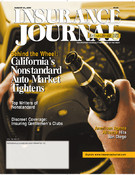With the fierce competition facing today’s nonstandard auto market, companies are pulling out all the stops in hopes of gaining market share. Some are employing different marketing and underwriting angles, while others are busy taking a completely different approach.
“I think the past couple of years has been a free-for-all,” said Don Lukenbill, spokesman for the American Agents Alliance. “A lot of companies had come in with these artificially low rates just to be competitive, and it started a downward spiral. And now the companies are realizing that they can’t sustain these rates.”
It’s a vicious cycle, and Jim Rogers, editor of The California Conduit, took the time to review the sequence of events with IJ. “The number of competitors increases,” he said. “The fight for market share and producers’ desktops begins with sales and marketing increasing personnel and spending.
“Of course, the next thing home office hears is that the program isn’t competitive enough, and steps are taken in that direction, the amount and type of ‘adjustment’ depending on how strong the underwriting and claims managers are-or are not. Finally, after a period of time, the loss experience for the liability tail, which is the prime driver, begins to worsen.”
Next comes the reversal of the processes mentioned above. This could happen one step at a time, or could even happen all at once.
“Some carriers just up and leave,” Rogers said. “[And] when adverse experience reaches the reinsurers, the feedback accelerates the entire process.”
Surviving the fall
Earlier this year, a wave of moratoriums crashed down on the private passenger nonstandard auto business, mainly affecting companies with newer programs. “I think that the programs that they were coming in with were just too low,” Lukenbill said, naming Deerbrook as one company that stopped writing nonstandard business for the time being. “And eventually, the losses caught up with them and they just couldn’t survive.”
In light of the situation, companies are now taking the necessary steps to keep their programs alive. Others have just stopped writing the business. While most are tightening up their underwriting guidelines, some are forcing mileage on their clients and others are making changes to their policies.
As one example, Lukenbill said that Progressive just switched to a six-month policy-a move he feels that other companies will soon follow. “And one of the GAs…won’t write a policy with under 10,000 annual miles,” Lukenbill said. “[In this situation], the client will get the rate at above 10,000 annual miles and the company will send them a down rate.”
Up, up and away
Just as the tides change, so do cycles of the market. “This is definitely a hard market,” said Jack Ellis, president of the National Auto Agents Alliance. “And I don’t think it’s just a matter of nonstandard [auto business]. I think…this hard market is all-encompassing from commercial lines to standard markets-everything is going up.”
Ellis said he has no idea how long this will last, but nobody really knows. “It’s the same as when we were in the soft market,” he said. “We didn’t know if it was ever going to bottom out as far as rates dropping.”
As a result, companies are keeping a close eye on the competition and jockeying for position. “Some approaches will be a little different from others as to how much of an increase they’ll take-some companies will do it on a gradual scale, maybe a 4 percent increase each quarter rather than taking a 10 or 12 percent increase if that’s what they’re looking at for the year,” Ellis said.
As with any line of business, companies know that they’ve got to be competitive and therefore, they know they’ve got to increase their rates. “Hopefully, they’ll still be in a very competitive mode when they do that,” Ellis said. “Because they might be competitive today, but does that mean when all is said and done, in another month or two, are they still going to be in that competitive mode?”
From the standpoint of sales, Ellis feels that this is going to be a hard sell in a hard market. In other words, those who thought they had a hard time retaining business in the soft market had better get prepared for what lies ahead.
“A year ago, there were times when I could save a customer $400 a year,” Ellis said. “But they opted not to do that because it would be a new company and it would have caused a new down payment. So instead, with the low rate, no down payment renewal, they stayed where they were, which led to a good retention on renewals, but now they’re going to be calling up asking why their price went up.”
The Alliance’s Lukenbill foresees a lot of rate increases-especially in the area of physical damage. “We’ve seen rate increases of 20 to 30 percent for some programs,” he said. “And that’s because physical damage…people are treating their insurance policy as a lottery ticket more now than before.”
In fact, one of the biggest obstacles in today’s nonstandard market, according to Lukenbill, is the high cost associated with driving a vehicle. This includes everything from fixing the car to high medical costs to high damage awards. “People get hit and they think they’ve just won the lottery, and all of this contributes to the high cost of insurance,” he said. “When you have premiums that are just so low and you are combining them with the high costs associated with driving and insuring a car, it just doesn’t balance out. Something has to come to a head.”
Grabbing hold of market share
“By far, the most unusual recent phenomenon has been the almost obsessive desire of just about every personal lines writer to add nonstandard auto to their lineup,” Rogers said. “Those already writing also seemed eager to try to wrestle for market share with the newcomers.”
Lukenbill agreed. “I think that if you’re an auto agent, you probably write some nonstandard, because think about it-you have somebody come into your office and he’s got a couple of tickets. What are you going to do? Turn him away?”
Most companies today have coverages available for all classes of drivers. For example, Progressive has a standard program, a preferred program and a nonstandard program. “So if you write with Progressive, you can put them into any one of those programs,” Lukenbill explained.
As for controlling the competition from the direct writers, Ellis feels that they are not spared from what’s going on in the nonstandard market. “I think the direct writers are going to slow themselves down,” he said. “They’re going to take some steps to get their book in a better order than what they’ve had in the past, and we might not be conscious or aware of these changes, but there will also be some underwriting changes made.”
Gotta have it
As the market continues to tighten, Ellis shared his view on what an independent agent can do to stay ahead of the competition. In his opinion, a lot of companies have dug their trenches and they’re ready. And the ones who haven’t are probably going to pay.
So what about the agents? “Now is the time to use that Yellow Page ad or radio spot,” Ellis said. “It was money down the drain back during the soft market, but now the phones are ringing-with this increase, they’re going to come to you.
“One thing with nonstandard is that you don’t have to worry about knocking on doors. They’ve got to have it and they’re going to be on the phone calling you for a quote.”
To comment on this article, please send e-mail to smingo@insurancejournal.com.
Was this article valuable?
Here are more articles you may enjoy.


 New York Regulates Consumer Litigation Financing
New York Regulates Consumer Litigation Financing  High-Net-Worth Risk Appetite Drops as Some Regions Show Stabilization
High-Net-Worth Risk Appetite Drops as Some Regions Show Stabilization  Howden Buys M&A Insurance Broker Atlantic Group in US Expansion
Howden Buys M&A Insurance Broker Atlantic Group in US Expansion  Kansas Man Sentenced to Probation for Insurance Fraud
Kansas Man Sentenced to Probation for Insurance Fraud 


